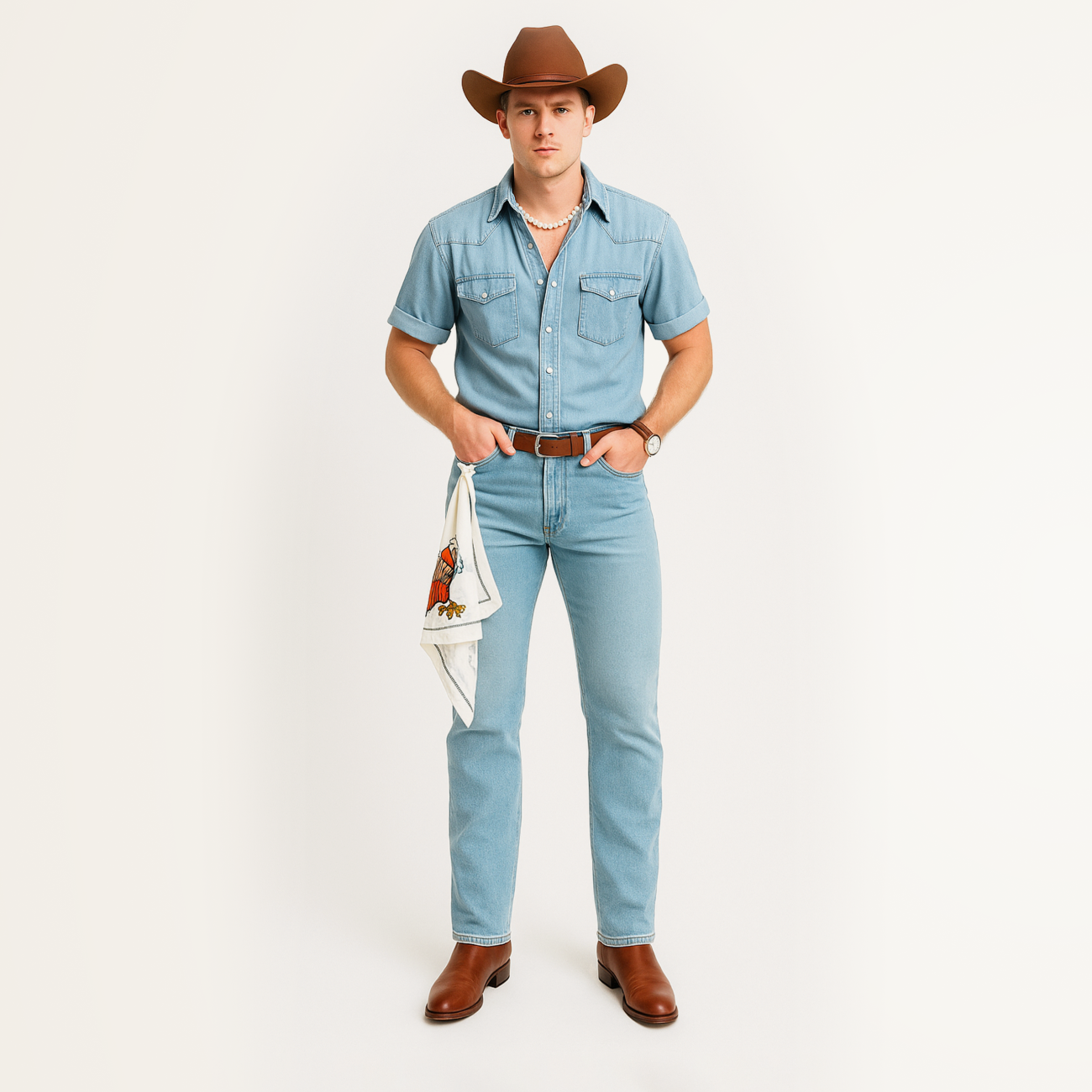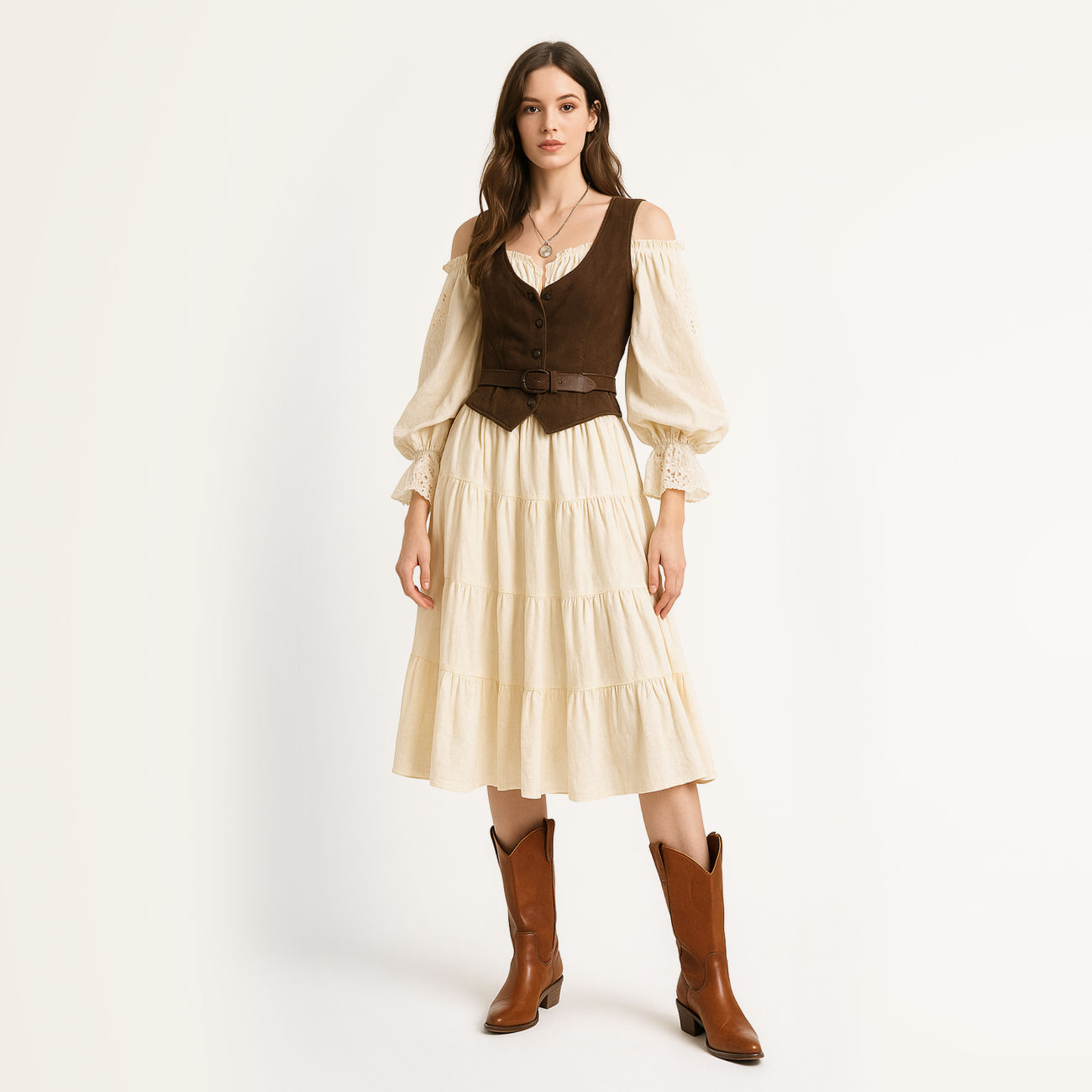Country
Cowboy style, or country style, not only expresses a love for simplicity and freedom, but also reflects a powerful connection with nature. This style emphasizes resilience and independence, bringing into fashion elements of the culture and heritage of the Wild West, with all its rugged romance. Behind the cowboy aesthetic lies a spirit of determination and self-assurance that has found its place in modern urban fashion. Cowboy style serves as a reminder of the importance of practicality, while also embracing intentional nonchalance and visual appeal. Its philosophy is rooted in the search for balance between freedom, authenticity, and functionality.
History
The history of cowboy style is a story of survival, practicality, and culture. In its earliest form during the 19th century, American cowboys were not setting out to create a style — their clothing was dictated by the demands of hard ranch work and long treks across vast prairies. Yet beyond this purely utilitarian approach, a unique cultural code emerged, blending features from multiple traditions and ultimately becoming a cornerstone of American fashion.
The roots of cowboy style lie in the dress of the Mexican vaqueros — hired cattle herders who worked on Spanish colonial ranches. The word vaquero literally means “herdsman” in Spanish. These early riders wore wide-brimmed hats for sun protection, loose trousers, and leather chaps to shield their legs from brush. As ranching expanded into U.S. territories, American cowboys adopted elements of Mexican dress, forming the base of what we now recognize as cowboy style, to which new details were gradually added.
By the late 19th century, the growth of agriculture in America led to a boom in ranches and a rising need for cowboys. Their garments were crafted to meet practical demands — durable denim jeans, functional shirts, leather jackets, and heeled boots to keep feet from slipping through stirrups. Wide-brimmed cowboy hats protected against sun and rain. These pieces had to endure harsh weather, dust, and wear. Functionality was the foundation for the now-iconic elements of the look.
In the early 20th century, the rise of the film industry helped launch the Western genre, which brought cowboy style into the mainstream. On-screen cowboys became symbols of independence, courage, and adventure. Iconic actors like John Wayne and Clint Eastwood portrayed heroic figures that elevated cowboy aesthetics into a symbol of American identity and strength. At the same time, the rise of country music further fueled the popularity of cowboy style.
Westerns not only romanticized cowboy life as bold and rugged — they helped enshrine the style as a cultural touchstone. These films captured the imagination of youth, painting a romantic image of freedom, rebellion, and the unvarnished life of the Wild West. The appeal transcended the U.S., finding fans among adventurers and nonconformists around the world.
Starting in the late 1960s, cowboy style enjoyed a renewed wave of popularity as elements of country culture merged with fashion through musical icons and the hippie aesthetic. In the 1970s, fringe jackets, jeans, and cowboy boots blended with hippie fashion, creating a unique fusion where the old frontier spirit met the freedom and experimentation of the new era. In the 1980s, cowboy fashion evolved into something more refined, thanks to designers like Ralph Lauren. This period cemented cowboy style as a pillar of American fashion — one that combined practicality with sophistication.
Since the early 2000s, cowboy style has continued to evolve, integrating into both streetwear and high fashion. Today, the aesthetic of the Wild West remains a powerful influence in everyday wear, cinema, and pop culture — constantly reinvented and forever symbolizing the unending pursuit of freedom.
Signature elements of the style
Color palette
This style adheres to earthy tones—brown, sand, olive—occasionally incorporating black, gray, and white. Deep indigo shades also appear, reminiscent of traditional denim fabrics.
Prints
Plaid and stripes are the two key prints in this style. Plaid—most often red and black on flannel shirts—is especially associated with the cowboy look. At times, ethnic motifs and patterns inspired by Native American culture are added.
Textures
Denim, leather, suede, heavy cotton, and wool are the key materials in cowboy style. These fabrics symbolize durability and comfort while giving the look its signature rugged texture. Suede or leather fringe on jackets and vests is an iconic detail, emphasizing movement and adding visual dynamism.
Cuts & silhouette
Straight, slightly loose silhouettes that ensure comfort and allow for freedom of movement.
Wardrobe essentials
- Hat: A classic cowboy hat with a wide brim and high crown.
- Plaid shirt: Often made of flannel or heavy cotton, featuring rounded chest pockets.
- Jeans: Straight-leg jeans, typically in heavy dark blue or indigo denim.
- Leather or suede fringe jacket: Adds movement to the look and is one of the most iconic cowboy elements.
- Cowboy boots, Western boots, ankle boots: High-shaft cowboy boots, sometimes decorated with embroidery or embossing.
- Belt with a large buckle: A statement piece symbolizing cowboy \
- Other accessories: Bandana, suspenders.
Substyles
Email: support@belt-app.com


















